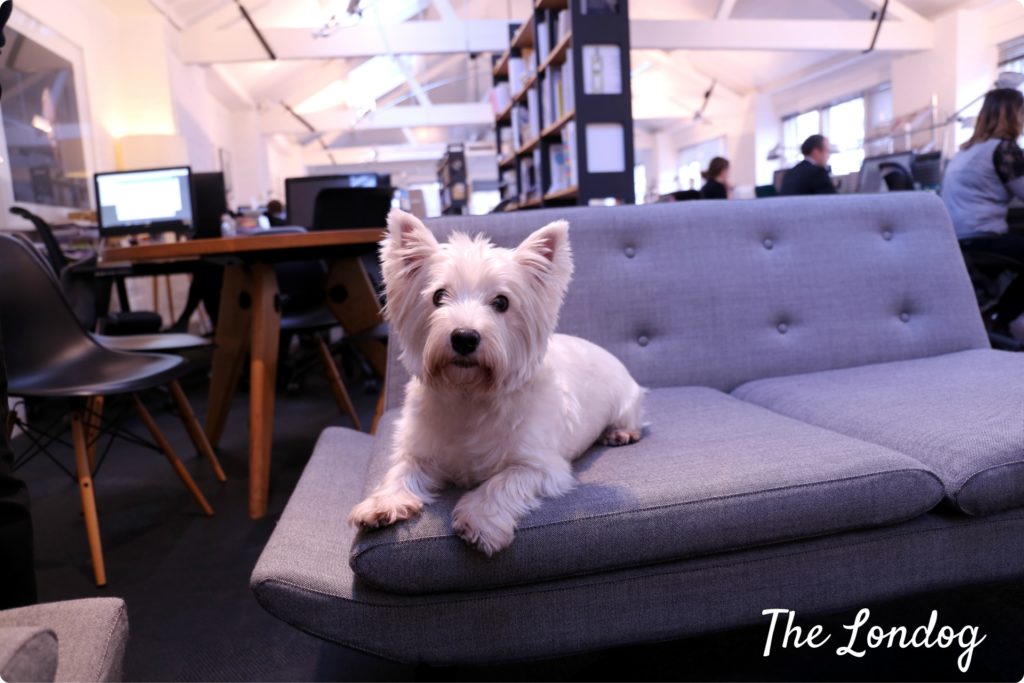Do you have an office dog? Would you love to bring your own dog to work? Perhaps, you feel that dogs have no place in the office. This week, we interview Cristina from The Londog and creator of the highly entertaining Office Dog series. Find out about the surprising benefits of working with dogs as well as a few of the drawbacks.

The Londog Iggy office dog at ING Media
What inspired you to start The Londog blog?
When I moved to London from overseas with my dog, Argo, I had a bit of a “dog-culture shock”. While on the one hand I was very positively impressed by the common off-leash policies of most parks, on the other hand, I hadn’t expected having to face challenges in finding dog-friendly accommodation, having to check the dog policy of each restaurant or shop (and also travelling from the UK and mainland Europe with a dog without a car). I come from a place where dogs can literally go anywhere; there are even laws which prohibit stores, restaurants, etc., to refuse you entering with your dog, so this was very unusual for me. I decided to share my experience of travelling with dogs, going to dog-friendly places, enclosed dog parks, to help other people, and I started The Londog blog. Using the blog as an excuse, I became interested in dog events and discovered a whole world that fascinated me and I wanted to recount stories about how dogs inspire their owners.
The Office Dog series had a singular start. I used to see this guy with his little dog on the train every morning. I started wondering whether he took him to work and I thought that it would have been a nice story to write for The Londog. The original idea was to write a single blog post featuring five office dogs that I had no idea how I would find – although I was very confident I would be able to -. I found the people and the dogs, but in the end their interview answers where so good and I was pleased with the photographs I had taken, that I decided to start a series: the Office Dog Series in the form of office dog weeks, with one dog a day for a week.
I feature an office dog week every two months and it has become my favourite blogging topic.

The Londog Otto, studio dog at The Crocodile – The Londog office dog series
How do you find the dogs that you feature on your Office dog series?
Haha! A magician never reveals his tricks…! I am joking, but really there is not only one way in which I find dogs to feature in the Office Dog Series, it mostly just happens. People I meet on the train, in the street or at the park, some of them then refer others. I have also started to receive messages from people who take their dogs to work and would like to be featured in the series.
I love the research aspect of the series, because I am quite a reserved person and this has pushed me out of my comfort zone… for example, to try and start a conversation with a perfect stranger on the train used to be something I was not very comfortable with in the beginning.
What are the benefits of having an office dog?
There are loads of benefits dogs bring in the work environment. The most frequent answer I get from the people I interview is that an office dog alleviates stress, helps people relax and cheers up/boosts the morale of employees. It can also be good for team building and brings health benefits for employees, being a good excuse for having a walk during their lunch break instead of sitting at the desk. In addition, it is an amazing ice-breaker with clients.
From a productivity point of view, dogs can also allow their owners to work longer hours, since they do not have to worry about leaving them alone longer and feel the urge to leave the office. Also, they help them saving on dog walker costs.
What are the downsides of having a dog in the office?
Probably the most common is the problem of accommodating the needs of people who don’t like or are allergic to dogs (employees/clients). You have to be sensitive to others and a dog can complicate things on this side.
You could have some downsides in the first adjustment period: most likely a bit more distraction from employees who want to cuddle the dog, etc., and initial potty training if you get a puppy (and securing cables etc.). After that stage, if the dog is well trained and well behaved ( and barks infrequently), I don’t see many downsides. Maybe apart from potential issues of other employees feeding the dog forbidden food.

The Londog Tilly Studio dog at Made by Many
Do you think having dogs at work is a growing trend and if so, why?
It is hard to tell. From what I have seen so far, it looks like many companies have introduced a dog policy only recently, so I would be tempted to say that it is a growing trend. Especially in the creative sector. However, I also found some companies that have taken a step back, following issues when employees have had allergies.
I believe that US companies are far more advanced in terms of dog policies, since a larger number of them allow their employees to take their dog to work. However, in contrast, these same companies do not allow dogs in their London offices.
Which breeds are best suited to working in offices?
Most dogs tend to settle while at the office, and go to sleep until it is walk-time or lunch-time – when most of them love to stare at people having lunch, hoping they will leave them some crumbs.
I have seen dogs of any breed going to the office and at this point I believe that, more than a breed factor, it depends on whether the dog receives enough exercise (outside of the office) for its breed and age – you would be surprised how much this makes a difference.
What facilities need to be in place in an office to enable an office dog to thrive?
An office dog requires to have a water bowl always at its disposal and a bed/crate in a quiet place where it can go to sleep and relax. Of course if you bring treats and a couple of toys (possibly not squeaky ones to avoid disturbing your colleagues), that is something that an office dog would surely appreciate!
What advice would you give to an employee who is considering approaching their employer with a request to bring their dog to work?
If I was to advise an employee considering to approach their employer with a request of this kind I would say pitch it explaining the benefits an office dog can bring to the company first. So mention stress reduction, increased productivity, team building, ice-breaking with clients and generally making the office a happier place.
One of the six principles of persuasion identified in a renowned book by psychology and marketing professor Robert Cialdini is social proof: people tend to look at what others are doing to make their choice. So you could cite examples of other companies that have adopted a dog policy. Hopefully you can find some inspiration in the Office Dog Series on The Londog!
Do you have a view on dogs at work? Please share your comments below.
